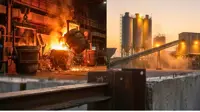European reinsurers outlook still negative
By Our Banking Bureau | 16 Aug 2002
 Chennai:
When
the outlook is negative for primary insurers, the prospects
for reinsurers, too, may not be different. In its report
on the European reinsurance market, the global credit
rating agency Standard and Poors (S&P) has said that
due to an uncertainty over the long-term sustainability
of rate increases, it is giving a negative outlook grading
for the industry.
Chennai:
When
the outlook is negative for primary insurers, the prospects
for reinsurers, too, may not be different. In its report
on the European reinsurance market, the global credit
rating agency Standard and Poors (S&P) has said that
due to an uncertainty over the long-term sustainability
of rate increases, it is giving a negative outlook grading
for the industry.
The interesting
aspect is that S&P is giving this grading for the
fifth year in succession. Recently, S&P had revised
its outlook to negative from stable for the European general
insurance industry.
"The negative outlook indicates that market trends
will continue to exert downward pressure on the credit
ratings on many reinsurers in the market, with rating
downgrades more prevalent than affirmations or upgrades,"
says S&Ps credit analyst Christian Dinesen.
After the 9/11 incidents in the US, major reinsurers have
increased their rates significantly across a variety of
business lines and also tightened the terms and conditions
of reinsurance contracts. This had its impact even on
Indian general insurers. For instance, all the general
insurance underwriters are covering terrorism risks as
an additional cover under their policies. Earlier, the
risk cover was an in-built one.
According to S&P, the new developments have sharply
enforced a market hardening that follows the very low
rating levels reached in 1998, which were subsequently
compounded by nine $1-billion catastrophe losses in 1999.
Nevertheless, the developments are not yet sufficient
to support a change in the outlook for the market, S&P
feels.
"Rates on some lines of business have not yet reached
a level where reinsurers will break even in terms of technical
underwriting," says S&Ps credit analyst Stephen
Searby. "To reach breakeven, rates need to increase
by about another 10-15 per cent." The main reason
S&P is maintaining its negative outlook for the reinsurance
industry is uncertainty over the sustainability of the
rate increases.
"Although S&P is fairly confident that most reinsurers
will reach a technical profit in the next 12 months, there
are very real risks that competition will re-emerge before
reinsurers have rebuilt their financial strength and are
ready to face additional large claims," says Searby.
Furthermore, reinsurers have made net pretax provisions
for losses arising from 9/11 of at least $15 billion in
addition to provisions made to accommodate the losses
from 1999, and they need several years of real profits
to recuperate.
"Although the reinsurance market is making firm statements
against the return to cyclicality, competition for market
share and more competitive, less profitable rates, it
has to prove that the old habits are dead and gone,"
adds Rob Jones, another credit analyst.
With significant industrial loss activity from the last
quarter of 2001 compounding the losses of 9/11, the market
suffered one of its least profitable years ever in terms
of pure underwriting. At the same time, although reinsurers
invest the majority of their assets in fixed-income bonds,
the downturn in global equity markets has exacerbated
the markets difficulties by putting yet more pressure
on capital.
Nevertheless, the
poor investment returns will contribute to enforcing market
underwriting discipline among reinsurers and their clients
the insurance companies who have greater exposure
to equities.
Searby warns that if the investments market resurges the
rate increases by reinsurers would be undermined, given
the current reinsurance market environment.
Continued depressed capital markets remain a key factor
in the longevity of the hard market. Although European
reinsurers are expected to remain consistent in their
underwriting approach well into 2003, history has shown
that falling costs of capital resulting from strong equity
markets and low interest rates are important factors in
establishing a softer premium rating environment.
"It is too early to say whether the high cyclicality
that has dogged the industry in the past few decades has
been removed. And there is no hard evidence to suggest
that in a profitable investment environment the market
will not return to cash flow underwriting or offering
multiyear deals," says Searby.
The importance of maintaining underwriting discipline
is highlighted by the recent loss activity. S&P now
estimates that about 35 per cent of net losses arising
from the terrorist actions of 9/11 have settled in the
European reinsurance market, with the total European loss
rising to nearer 50 per cent when primary insurers retentions
are included.
With the absence of any unusual loss activity for the
rest of 2002, meanwhile, the benign claims environment
allied to the recent rate increases should see a relatively
high level of profitability on large property accounts.
Nevertheless, concerns remain in the market over asbestosis,
toxic mould, and directors and officers (D&O) liabilities.
Although the majority of claims activity arising from
related loss activity has settled in the US to date, there
is potential for it to spread to Europe.
"France and the UK have already experienced asbestosis-related
court cases, while US claims from both toxic mould and
D&O policies are growing large enough to potentially
trigger some reinsurance policies, some of which will
most likely reach the European market," says Dinesen.
Latest articles
Featured articles

Hariman Sharma lets apple travel to India’s warmer climes
10 Feb 2025
Apple, which was the preserve of the cooler Himalayan region in India, is now everywhere – in the East, the West and the South - thanks to one enterprising Himachal farmer, Hariman Sharma.

The cost of neglecting water transport
03 Feb 2025
Inland water transport is widely recognised as a cheaper and environment friendly mode of transport and, as per a report prepared by RITES

Crypto Currencies Trying To Undermine Global Financial System
27 Jan 2025
US President Donald Trump, it seems, is the latest to join the frenzy for personal or corporate currency, with $TRUMP, or what they call a meme coin, giving a further boost to his crypto image.

As costs of saying final goodbyes rise UK families resort to crowdfunding to pay for funerals
By Axel Miller | 16 Jan 2025
The cost of saying a final goodbye to loved ones in the UK has reached a grim new high, leaving families grappling with unexpected financial burdens.

The life and times of Manmohan Singh, former Prime Minister of India
By Cygnus | 28 Dec 2024
On 27th December 2024 India and the world lost one of their finest statespersons in a hundred years. Manmohan Singh, born on 26th September 1932, in Gah, Punjab (now in Pakistan)

The remarkable Ratan Tata
By Kiron Kasbekar | 23 Oct 2024
One newspaper report of Ratan Tata’s passing away showed an old photo of him climbing into the cockpit of a Lockheed Martin F-16 fighter.

Lighter than air, yet very, very powerful
By Kiron Kasbekar | 03 Jan 2024
In March 2013 Chinese scientists pulled off a remarkable feat. They created the world’s lightest aerogel. Tipping the scales at a mere 0.16 milligrams per cubic centimeter – that’s a sixth of the weight of air!

COP28 explained: A closer look at COP28's climate change solutions
By Aniket Gupta | 27 Dec 2023
The 28th United Nations Climate Change Conference, also known as COP28, took place from 30th November 2023, to 13th December 2023, at Expo City in Dubai, United Arab Emirates.

What is a Ponzi scheme?
By Aniket Gupta | 06 Dec 2023
Ponzi schemes have long captivated the public imagination, drawing unsuspecting investors into a web of illusion and deception.
Business History Videos

History of hovercraft Part 3...
By Kiron Kasbekar | Presenter: Kiron Kasbekar

History of hovercraft Part 2...
By Kiron Kasbekar | Presenter: Kiron Kasbekar

History of Hovercraft Part 1...
By Kiron Kasbekar | Presenter: Kiron Kasbekar










